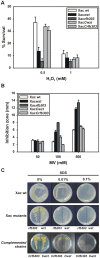Modifications of Xanthomonas axonopodis pv. citri lipopolysaccharide affect the basal response and the virulence process during citrus canker
- PMID: 22792211
- PMCID: PMC3391215
- DOI: 10.1371/journal.pone.0040051
Modifications of Xanthomonas axonopodis pv. citri lipopolysaccharide affect the basal response and the virulence process during citrus canker
Abstract
Xanthomonas axonopodis pv. citri (Xac) is the phytopathogen responsible for citrus canker, one of the most devastating citrus diseases in the world. A broad range of pathogens is recognized by plants through so-called pathogen-associated molecular patterns (PAMPs), which are highly conserved fragments of pathogenic molecules. In plant pathogenic bacteria, lipopolisaccharyde (LPS) is considered a virulence factor and it is being recognized as a PAMP. The study of the participation of Xac LPS in citrus canker establishment could help to understand the molecular bases of this disease. In the present work we investigated the role of Xac LPS in bacterial virulence and in basal defense during the interaction with host and non host plants. We analyzed physiological features of Xac mutants in LPS biosynthesis genes (wzt and rfb303) and the effect of these mutations on the interaction with orange and tobacco plants. Xac mutants showed an increased sensitivity to external stresses and differences in bacterial motilities, in vivo and in vitro adhesion and biofilm formation. Changes in the expression levels of the LPS biosynthesis genes were observed in a medium that mimics the plant environment. Xacwzt exhibited reduced virulence in host plants compared to Xac wild-type and Xacrfb303. However, both mutant strains produced a lower increase in the expression levels of host plant defense-related genes respect to the parental strain. In addition, Xac LPS mutants were not able to generate HR during the incompatible interaction with tobacco plants. Our findings indicate that the structural modifications of Xac LPS impinge on other physiological attributes and lead to a reduction in bacterial virulence. On the other hand, Xac LPS has a role in the activation of basal defense in host and non host plants.
Conflict of interest statement
Figures









Similar articles
-
Structural analysis and involvement in plant innate immunity of Xanthomonas axonopodis pv. citri lipopolysaccharide.J Biol Chem. 2011 Jul 22;286(29):25628-43. doi: 10.1074/jbc.M110.186049. Epub 2011 May 19. J Biol Chem. 2011. PMID: 21596742 Free PMC article.
-
A LOV protein modulates the physiological attributes of Xanthomonas axonopodis pv. citri relevant for host plant colonization.PLoS One. 2012;7(6):e38226. doi: 10.1371/journal.pone.0038226. Epub 2012 Jun 4. PLoS One. 2012. PMID: 22675525 Free PMC article.
-
The monofunctional catalase KatE of Xanthomonas axonopodis pv. citri is required for full virulence in citrus plants.PLoS One. 2010 May 24;5(5):e10803. doi: 10.1371/journal.pone.0010803. PLoS One. 2010. PMID: 20520822 Free PMC article.
-
Bacteria causing important diseases of citrus utilise distinct modes of pathogenesis to attack a common host.Appl Microbiol Biotechnol. 2010 Jun;87(2):467-77. doi: 10.1007/s00253-010-2631-2. Epub 2010 May 7. Appl Microbiol Biotechnol. 2010. PMID: 20449739 Review.
-
PAMPs, PRRs, effectors and R-genes associated with citrus-pathogen interactions.Ann Bot. 2017 Mar 1;119(5):749-774. doi: 10.1093/aob/mcw238. Ann Bot. 2017. PMID: 28065920 Free PMC article. Review.
Cited by
-
Deletion of pilA, a Minor Pilin-Like Gene, from Xanthomonas citri subsp. citri Influences Bacterial Physiology and Pathogenesis.Curr Microbiol. 2016 Dec;73(6):904-914. doi: 10.1007/s00284-016-1138-1. Epub 2016 Sep 24. Curr Microbiol. 2016. PMID: 27664015
-
A Comprehensive Overview of the Genes and Functions Required for Lettuce Infection by the Hemibiotrophic Phytopathogen Xanthomonas hortorum pv. vitians.mSystems. 2022 Apr 26;7(2):e0129021. doi: 10.1128/msystems.01290-21. Epub 2022 Mar 21. mSystems. 2022. PMID: 35311560 Free PMC article. Review.
-
Recognition of Elicitors in Grapevine: From MAMP and DAMP Perception to Induced Resistance.Front Plant Sci. 2019 Sep 18;10:1117. doi: 10.3389/fpls.2019.01117. eCollection 2019. Front Plant Sci. 2019. PMID: 31620151 Free PMC article. Review.
-
Xanthomonas bacteriophages: a review of their biology and biocontrol applications in agriculture.BMC Microbiol. 2021 Oct 25;21(1):291. doi: 10.1186/s12866-021-02351-7. BMC Microbiol. 2021. PMID: 34696726 Free PMC article. Review.
-
Immunosuppression during Rhizobium-legume symbiosis.Plant Signal Behav. 2014;9(3):e28197. doi: 10.4161/psb.28197. Epub 2014 Jan 1. Plant Signal Behav. 2014. PMID: 24556951 Free PMC article.
References
-
- Brunings AM, Gabriel DW. Xanthomonas citri: breaking the surface. Mol Plant Pathol. 2003;4:141–157. - PubMed
-
- Gottwald TR, Sun X, Riley T, Graham JH, Ferrandino F, et al. Geo-referenced spatiotemporal analysis of the urban citrus canker epidemic in Florida. Phytopathology. 2002;92:361–377. - PubMed
-
- Graham JH, Gottwald TR, Cubero J, Achor DS. Xanthomonas axonopodis pv. citri: factors affecting successful eradication of citrus canker. Mol Plant Pathol. 2004;5:1–15. - PubMed
-
- Vorhölter FJ, Niehaus K, Pühler A. Lipopolysaccharide biosynthesis in Xanthomonas campestris pv. campestris: a cluster of 15 genes is involved in the biosynthesis of the LPS O-antigen and the LPS core. Mol Genet Genomics. 2001;266:79–95. - PubMed
Publication types
MeSH terms
Substances
LinkOut - more resources
Full Text Sources

